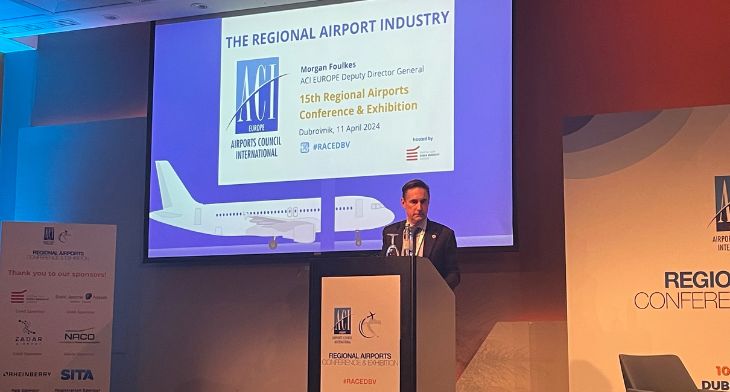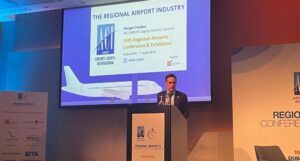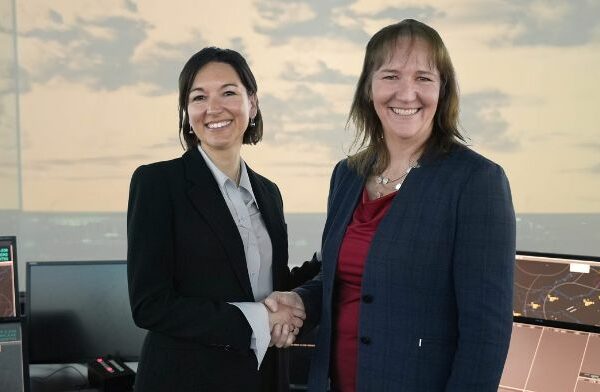


Under the theme “Navigating Change”, Europe’s regional airport community have been busy discussing changing market conditions and existential challenges at this year’s Airports Council International (ACI) Europe Regional Airports Conference and Exhibition (RACE), which was hosted by Dubrovnik’s Ruder Boskovic Airport in Croatia.


“We have barely turned a corner on COVID, but its aftermath is here to stay in the guise of new market dynamics keeping a tight grip on regional airports,” Foulkes said.
He also noted that “increasing dependence of these airports on footloose LCCs and hybridised network carriers is exacerbating competitive pressure, often squeezing them with unprecedented intensity. And clearly, the stream of airline consolidations underway is not going to make things any easier.”
Bullish summer ahead
Telling Europe’s larger regional airports to prepare for a “bullish summer” in terms of airline seats, he noted that smaller regional airports are also worse off in terms of airline seats with carriers not putting seats into those markets. “Ryanair, Wizz Air, Pegasus and Jet2 are all adding capacity. However, supply chain challenges will result in a downsizing of operations for other carriers,” he said.
Highlighting that strikes, ATM capacity, disruptive weather and the implementation of the Schengen Entry/ Exit System (EES) remain pain points for Europe’s airport community, Foulkes also pointed to “strong consumer confidence defining the market, with consumers increasingly moving from material purchases to investing in experiences, including travel.”
He also stated that sustainability remains at the forefront of the airport agenda, but the focus is also on macro-economic tensions and uncertainties due to supply side pressures and bottlenecks as well as increased geopolitical risks and fragmentation. Massive debt load across the global airport community is another dominant focus, after airports decreased charges during COVID to help airlines, but have not increased them since in line with inflation. Regional airports in particular are also struggling when it comes to non-aeronautical revenues, stated Foulkes, but with geopolitical tensions an ongoing concern they need to remain dynamic and flexible when it comes to alternative revenue streams.
“With an investment crunch ahead and a €27 billion shortfall for the period 2022 to 2024, ensuring state aid remains available to regional airports is crucial,” he said.
Decarbonising airports
As day one of the conference progressed, sustainability and achieving net zero emissions remained a key topic of the day.
Panellists discussed how electric/ hybrid aircraft will redefine regional connectivity, with Pim Meyboom, Senior Project Manager for NACO revealing that airports frequently ask how they should be preparing for the future.
“Looking ahead, airports need to be prepared for hydrogen and electric fuelling as well as still offering conventional aviation fuel and sustainable aviation fuel (SAF). They want to know what that landscape looks like and how they can manage the multiple fuelling requirements,” he said.
“The additional weight of hybrid and electric aircraft will also mean that some airports will need to extend their runways, while for others the power infrastructure is not sufficient to support the recharging requirements of these flights so that all has to be addressed.”
He also pointed to the benefits of these next-generation aircraft with lower operational costs being a key one. And while these technologies remain a way off from being deployed at commercial scale, panellists and delegates alike recognised the need to be developing this space now.
Kata Cserep, Global Aviation Lead at PA Consulting led a panel discussing how to get SAF at regional airports, with the lack of supply, as well as the high cost and challenges with transporting the fuel in an environmentally friendly way all hindering the wider adoption of SAF.
Simon Dreschel, Executive Chairman and Manaing Director at Bordeaux Airport revealed that his airport is working with Total Energie to create a local SAF supply chain. “The SAF molecules are transported by boat to Bordeaux, where it is blended at the port and transported the last leg of its journey by truck. We have SAF in our tanks, but the problem we have is that the commercial carriers aren’t uplifting it.”
Groningen Airport Eelde, the first hydrogen valley airport in Europe shared its vision for what future airports with hydrogen refuelling capabilities could look like. CEO, Meiltje de Groot urged national and European government to get behind these projects not just in terms of funding, but also in securing the necessary certification and regulations around hydrogen or alternative fuelling.
No airport left behind
When it comes to zero emissions, regional airports have embraced the need to decarbonise their operations with more than 260 regional airports across Europe certified for carbon management and reduction on the Airport Carbon Accreditation scheme.
Ireland West Airport’s Joe Gilmore referenced the projects that his airport have implemented, including LED lighting, solar panels and more effective recycling of waste. However, he also noted: “This all comes at a significant cost, especially when you look at the investment needed to decarbonise the terminal infrastructure itself.”
Swedavia’s Director, Strategic Initiatives and Innovation, Fredrik Jaresved, emphasised the need to ensure the message about what airports are doing is shared with the wider public and passengers in particular. “We need to strike the balance of sharing what we’re doing, while not over communicating,” he said. “But it’s our responsibility to explain what we’re doing and the role passengers play,” he said, noting that the Swedish airport operator is running commercials on social media referencing what it is doing to decarbonise operations.
Meanwhile, Nicola Robbins, Partner at Oxera Consulting, revealed that the EU Fit for 55 package could result in up to a 20% decrease in passenger traffic for regional airports. This, she said, would translate into much degraded air connectivity and thus impact the economic and social position of Europe’s regional communities.
And as airports increasingly look at facilitating the deployment of zero-emission aircraft, they need to be factored in along with the rest of the airport industry into the EU and national energy policies. This is about securing not just the availability of SAF, but also access to green energy at competitive and undistorted prices.
“With the EU is about to embark on a new five-year political cycle and as we hear much about the need for competitive and social impacts to be addressed while we decarbonise our economies, it is essential that no airport and no community is left behind,” said Foulkes.
“That means ensuring we decarbonise aviation in a way that safeguards the unique economic and social benefits of air connectivity in the regions,” he concluded, pointing to ACI Europe’s Airport Industry Manifesto, which was published in January and which asks EU institutions to do just that.





